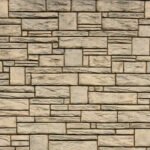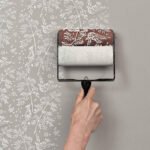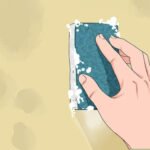If you have old, outdated wallpaper that you want to cover up, painting over it is an affordable and easy option. With some basic preparation and the right painting technique, you can transform the look of a room without the hassle of removing wallpaper.
In this detailed guide by Land of Wallpaper, we will walk through how to paint over wallpaper, everything you need to know to properly prepare the wallpapered walls, and select and apply paint for a smooth finished look. We will also provide tips on choosing paint sheen and color. With a little bit of effort, some mild scraping, sanding, and cleaning, and 2 coats of paint, you can give your old walls a brand-new look.
Step-by-Step Guide to Paint Over Wallpaper
Step 1: Prepare the Wallpapered Walls
Properly preparing the walls is the most important step before painting over wallpaper. If the walls are not properly prepped, the paint can peel off along with the wallpaper. Here is how to prepare the walls:
- Lightly score the existing wallpaper using a scoring tool or very fine sandpaper. This roughs up the surface so the paint can adhere better. Avoid gouging too deeply.
- Use a mixture of hot water and fabric softener or diffused vinegar water in a spray bottle to saturate the wallpaper. Let it soak in for 5 minutes. This allows the existing wallpaper glue to soften for easier removal.
- Gently peel off any loosened wallpaper using a putty knife or paint scraper. For stubborn areas, reapply the liquid mixture and let soak before attempting to peel again.
- Lightly sand the entire wall surface after removing wallpaper pieces. This roughens up the remaining wallpaper and glue residue.
- Fill any holes, cracks, or uneven spots with lightweight spackle compound and let dry completely. Then sand smooth.
- Wash walls with trisodium phosphate (TSP) cleaner and rinse to remove any remaining glue or soap residue. Let dry fully before painting.
Step 2: Pick the Right Paint Type
For the best paint adhesion and durability on wallpapered walls, use high-quality latex or acrylic interior paint. Avoid flat paints, as they do not adhere well to wallpaper. Here are the best paint finishes to use:
- Eggshell or Satin Finish: Provides a subtle sheen that makes walls washable. The finish is not too shiny.
- Semi-Gloss: This medium to high sheen option is very durable and scrubbable. It works well in high-traffic areas like hallways and family rooms.
- Primer/Paint Combo: Consider using a combo product made specifically for painting over wallpaper. It serves as both primer and paint in one.
No matter what finish you select, always opt for paints with a binding primer already mixed in for best adhesion.
Step 3: Apply a Wallpaper Paint Primer
Priming the walls after you have removed the wallpaper pieces and properly prepared them is extremely important. A quality primer designed for wallpaper provides an extra bonding layer that helps the paint better adhere to the slick wallpaper surface.
Some all-in-one primer/paint products made for painting over wallpaper already include primer, so you can skip this step. If using regular wall paint, be sure to prime the walls first with one of these recommended primers:
- Drywall Primer: Provides extra gripping power to surfaces like wallpaper.
- Stain Blocking Primer: Stops stains from bleeding through new paint. Useful if your wallpapered walls contain smoke stains or water stains.
- Oil-Based Primer: Adheres perfectly to glossy or slick surfaces like old wallpaper.
Apply primer evenly across all prepared wallpaper walls using a premium roller sleeve or nylon/polyester brush. Allow to dry fully before painting.
Step 4: Paint the Wallpapered Walls Properly
Once your primer has dried completely, you are ready to apply the paint color of your choice. Follow these tips when painting over wallpaper to get a smooth painted surface:
- Always follow your paint manufacturer’s instructions for proper application thickness and drying times between coats.
- For the smoothest finish, apply paint in long, even strokes and maintain a “wet edge” so each stroke blends seamlessly into the next section.
- Use a premium quality roller sleeve designed for smooth surfaces. This creates a more consistent finish.
- Paint all walls in sections from top to bottom or in 4×4 foot squares so there are no visible start and stop points.
- Inspect walls after each coat, under lighting, to check for any imperfections that require touch-ups. The color should look smooth and opaque after two coats.
Pro Tip: For added paint bonding power, consider applying a wallpaper adhesion promoter before priming or painting the prepared wallpaper walls. Adhesion promoters work to form a grip coating so the paint sticks tightly.
Step 5: Choose Interior Paint Sheen and Color
One of the great benefits of painting over outdated wallpaper is choosing a fresh new wall color. You can match the existing interior décor or go for a whole new look. Consider these tips when selecting wall paint color and sheen when painting over wallpaper:
Paint Sheen Recommendations by Room
- Bathrooms/Kitchens: Semi-Gloss or Gloss Finish. These add wipe ability.
- Bedrooms/Living Rooms: Eggshell or Satin Finish. Provides rich color and some subtle sheen.
- Entryways/Halls: Satin or Semi-Gloss Finish. Stands up well to traffic and kids.
- Ceilings: Flat Finish is perfect to hide ceiling imperfections
Choosing Wall Colors
Coordinate color with flooring, furnishings, and lighting fixtures. For a sense of expanded space, choose lighter cool tones like soft greens or grays. Warm earthy tones like tan, red, or orange feel cozy and inviting. Bold, dramatic colors make a statement but can overwhelm a room. Instead, use them as accent walls combined with neutral base wall colors.
Conclusion
Painting over outdated or damaged wallpaper allows you to inexpensively refresh a room without tediously steaming off old wallpaper. Follow our preparation guide to know how to paint over wallpaper perfectly. Make sure you pay attention to all these tips when painting over wallpaper for beautiful walls that look crisp not aged, like new construction. With a little bit of elbow grease, the right primers and paints, and some colorful creativity, you can transform the look of a room.





